
Chandni Chowk
Encyclopedia
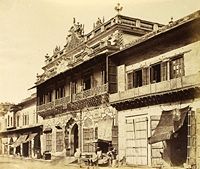
Old Delhi
Old Delhi , walled city of Delhi, India, was founded as Shahjahanabad by Mughal Emperor Shahjahan in 1639. It remained the capital of the Mughals until the end of the Mughal dynasty....
, now in central north Delhi
Delhi
Delhi , officially National Capital Territory of Delhi , is the largest metropolis by area and the second-largest by population in India, next to Mumbai. It is the eighth largest metropolis in the world by population with 16,753,265 inhabitants in the Territory at the 2011 Census...
, India
India
India , officially the Republic of India , is a country in South Asia. It is the seventh-largest country by geographical area, the second-most populous country with over 1.2 billion people, and the most populous democracy in the world...
. Built in 17th century by Shah Jahan
Shah Jahan
Shah Jahan Shah Jahan (also spelled Shah Jehan, Shahjehan, , Persian: شاه جهان) (January 5, 1592 – January 22, 1666) Shah Jahan (also spelled Shah Jehan, Shahjehan, , Persian: شاه جهان) (January 5, 1592 – January 22, 1666) (Full title: His Imperial Majesty Al-Sultan al-'Azam wal Khaqan...
and designed by his daughter Jahan Ara
Jahan Ara
Jahan Ara or is a Muslim female first name in South Asia.* Jahanara Begum, daughter of Mughal Emperor, Shah Jahan* Jahanara Imam* Begum Jahanara Shahnawaz* Jehan Ara Begum*Jahan Ara...
, the market was once divided by canals to reflect moonlight, now closed, yet it still remains one of Asia's largest whole sale markets.
History

Old Delhi
Old Delhi , walled city of Delhi, India, was founded as Shahjahanabad by Mughal Emperor Shahjahan in 1639. It remained the capital of the Mughals until the end of the Mughal dynasty....
, which was originally called Shahjahanabad. The walled city, which includes the Lal Qila or Red Fort of Delhi, was established in 1650 AD by the Mughal Emperor Shah Jahan
Shah Jahan
Shah Jahan Shah Jahan (also spelled Shah Jehan, Shahjehan, , Persian: شاه جهان) (January 5, 1592 – January 22, 1666) Shah Jahan (also spelled Shah Jehan, Shahjehan, , Persian: شاه جهان) (January 5, 1592 – January 22, 1666) (Full title: His Imperial Majesty Al-Sultan al-'Azam wal Khaqan...
. It was designed by his daughter Jahanara Begum Sahib, who also made significant contributions in the landscaping of her father's new capital.
Chandni Chowk runs through the middle of the walled city, from the Lahori Darwaza (Lahore Gate) of the Red Fort to Fatehpuri Masjid
Fatehpuri Masjid
Fatehpuri Masjid is a 17th-century mosque located at the western end of the oldest street of Delhi, Chandni Chowk. It thus counterbalances the Red Fort on the opposite end of Chandni Chowk...
. Originally, a canal ran through the middle of the street as a part of the water supply scheme. It was initially divided into three sections:
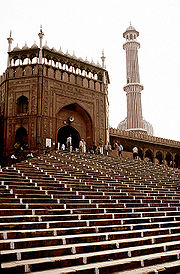
- Lahori darwaza to Chowk Kotwali (near Gurdwara Shish Ganj): This section closest to the imperial residence, was called Urdu BazarUrdu BazarThe Urdu Bazar was a major market in the walled city of Delhi, India that connected the canal in the middle of Chandni Chowk to Jama Masjid. The original market was destroyed in the aftermath of Indian Rebellion of 1857, but its name survives as a location near the Jama Masjid. The Urdu language...
, i.e., the encampment market. The language UrduUrduUrdu is a register of the Hindustani language that is identified with Muslims in South Asia. It belongs to the Indo-European family. Urdu is the national language and lingua franca of Pakistan. It is also widely spoken in some regions of India, where it is one of the 22 scheduled languages and an...
got its name from this encampment. Ghalib noted the destruction of this market during the disturbances of the Indian Rebellion of 1857Indian Rebellion of 1857The Indian Rebellion of 1857 began as a mutiny of sepoys of the British East India Company's army on 10 May 1857, in the town of Meerut, and soon escalated into other mutinies and civilian rebellions largely in the upper Gangetic plain and central India, with the major hostilities confined to...
and its aftermath. - Chowk Kotwali to Chandni Chowk: The term Chandni Chowk originally referred to the square that initially had a reflecting pool. It was replaced by a clock-tower (Ghantaghar) that was damaged and demolished in the 1960s. This section was originally called Johri Bazar.
- 'Chandni Chowk' to Fatehpuri MasjidFatehpuri MasjidFatehpuri Masjid is a 17th-century mosque located at the western end of the oldest street of Delhi, Chandni Chowk. It thus counterbalances the Red Fort on the opposite end of Chandni Chowk...
: This was called the Fatehpuri Bazar.
It is said that moonlight reflecting on its canal, earned it its name, Chandni (Moonlit).
Chandni Chowk was once the grandest of the markets in India.



- Haveli: a mansion. A normal haveli would have a big courtyard (atrium) surrounded on four sides by spacious rooms and often another walled courtyard around the exterior as well. One of the largest preserved havelis in the area is the Chunnamal haveliChunnamal haveliRai Lala Chunnamal ki Haveli is the only well-preserved haveli in the walled city of old Delhi in the Chandni Chowk area.Lala Chunnamal and his family were Khatri merchants of brocade and textiles during the Mughal period...
. - Kucha: a zone with houses whose owners shared some common attribute, usually their occupation. Hence the names Maliwara, the gardeners' neighborhood and Ballimaran, the oarsmen’s neighborhood.
- Katra: refers to a separate wing of tradesmen and craftsmen belonging to the same trade. They usually lived and worked together. A system similar to the guild housing in Amsterdam.And it was shown as a favourite city of khushi kumari gupta and home city of arnav singh raizaada in serial iss pyaar ko kya naam doon.
Overview
The area lies in the historically important Shahjahanabad, between the Lal Qila (The Red Fort) and Fatehpuri MasjidFatehpuri Masjid
Fatehpuri Masjid is a 17th-century mosque located at the western end of the oldest street of Delhi, Chandni Chowk. It thus counterbalances the Red Fort on the opposite end of Chandni Chowk...
. On both sides of the wide Chandni Chowk streets are historical residential areas served by narrow lanes (galis).
With the most famous mosque of Delhi, Jama Masjid, built in 1650 in the vicinity, it is an unusual street that has several famous religious shrines, belonging to different religions, that coexist, lending the street a genuine cultural harmony. Starting from the Red fort, the street has:
- Sri Digambar Jain Lal MandirSri Digambar Jain Lal MandirShri Digambar Jain Lal Mandir is the oldest and best-known Jain temple in Delhi, India. It is directly across from the Red Fort in the historical Chandni Chowk area.It is known for an avian veterinary hospital in a second building behind the main temple....
, established in 1656 with a bird hospital established in 1929. There is also a Naya MandirNaya MandirNaya Mandir is a historic Jain temple in Old Delhi, in the Dharampura locality allocated to the Jain community by Aurangzeb....
built in 1807 nearby in Dharampura, which was the first temple with a shikhar permitted. - HinduHinduHindu refers to an identity associated with the philosophical, religious and cultural systems that are indigenous to the Indian subcontinent. As used in the Constitution of India, the word "Hindu" is also attributed to all persons professing any Indian religion...
Gauri Shankar Temple built by a Maratha general Appa Gandgadhar in 1761. - ChristianChristianA Christian is a person who adheres to Christianity, an Abrahamic, monotheistic religion based on the life and teachings of Jesus of Nazareth as recorded in the Canonical gospels and the letters of the New Testament...
Central Baptist ChurchCentral Baptist Church (Delhi)Central Baptist Church is located on the main Chandni Chowk Road, just opposite Gurdwara Sisganj and before the Fountain Chowk in Delhi, India. It is probably the oldest Christian mission in the whole of the northern Indian region...
built in 1814.

- SikhSikhA Sikh is a follower of Sikhism. It primarily originated in the 15th century in the Punjab region of South Asia. The term "Sikh" has its origin in Sanskrit term शिष्य , meaning "disciple, student" or शिक्ष , meaning "instruction"...
Gurdwara Sis Ganj SahibGurdwara Sis Ganj SahibGurdwara Sis Ganj Sahib, is one of the nine historical gurdwaras in Delhi. First established in 1783 by Baghel Singh to commemorate the martyrdom site the ninth Sikh Guru, Guru Tegh Bahadur...
. The 9th SikhSikhA Sikh is a follower of Sikhism. It primarily originated in the 15th century in the Punjab region of South Asia. The term "Sikh" has its origin in Sanskrit term शिष्य , meaning "disciple, student" or शिक्ष , meaning "instruction"...
Guru, Guru Tegh Bahadur and his followers Bhai Mati DasBhai Mati DasBhai Mati Das Bhai Mati Das Bhai Mati Das (Punjabi: ਭਾਈ ਮਤੀ ਦਾਸ, is one of the greatest martyrs in Sikh history. He along with his younger brother Bhai Sati Das and Bhai Dyal Das, all disciples of the ninth Sikh Guru, Guru Tegh Bahadur, were executed along with him at the Kotwali(police-station)...
, Bhai Dyal Das and Bhai Sati DasBhai Sati DasBhai Sati Das along with his elder brother Bhai Mati Das is one of the greatest martyrs in Sikh history. Bhai Sati Das and his elder brother Bhai Mati Das were followers of ninth Sikh Guru, Guru Tegh Bahadur...
were executed nearby by the Mughals in 1675 A.D. The Gurudwaras in the form of memorials were built in 1783 after Delhi, the then Mughal capital, was captured by the Khalsa(the corporate body of Sikhs) under the command of Baba Baghel SinghBaghel SinghBaghel Singh was an important military general during turbulent times in Punjab in the 18th century. He was born in the village of Chabal Kalan near the city of Tarn Taran Sahib in the Taran Taran district...
. - MuslimMuslimA Muslim, also spelled Moslem, is an adherent of Islam, a monotheistic, Abrahamic religion based on the Quran, which Muslims consider the verbatim word of God as revealed to prophet Muhammad. "Muslim" is the Arabic term for "submitter" .Muslims believe that God is one and incomparable...
Sunehri MasjidSunehri MasjidSunehri Masjid سنهرى مسجد is an Indian mosque located near the Gurudwara Sis Ganj Sahib in Chandni Chowk, Delhi, once an imperial boulevard leading to the Red Fort...
built in 1721 by Roshan-ud-Daula Zafar Khan in the reign of Mohammad Shah. The PersianPersian peopleThe Persian people are part of the Iranian peoples who speak the modern Persian language and closely akin Iranian dialects and languages. The origin of the ethnic Iranian/Persian peoples are traced to the Ancient Iranian peoples, who were part of the ancient Indo-Iranians and themselves part of...
invader Nadir Shah spent several hours on the top of the mosque on 11 March 1739 to observe the Katl-e-Aam (the killing of everyone in sight) that he had ordered which resulted in 30,000 deaths. - MuslimMuslimA Muslim, also spelled Moslem, is an adherent of Islam, a monotheistic, Abrahamic religion based on the Quran, which Muslims consider the verbatim word of God as revealed to prophet Muhammad. "Muslim" is the Arabic term for "submitter" .Muslims believe that God is one and incomparable...
Fatehpuri MasjidFatehpuri MasjidFatehpuri Masjid is a 17th-century mosque located at the western end of the oldest street of Delhi, Chandni Chowk. It thus counterbalances the Red Fort on the opposite end of Chandni Chowk...
built by Fatehpuri Begum in 1650, one of the queens of Shah JahanShah JahanShah Jahan Shah Jahan (also spelled Shah Jehan, Shahjehan, , Persian: شاه جهان) (January 5, 1592 – January 22, 1666) Shah Jahan (also spelled Shah Jehan, Shahjehan, , Persian: شاه جهان) (January 5, 1592 – January 22, 1666) (Full title: His Imperial Majesty Al-Sultan al-'Azam wal Khaqan...
.
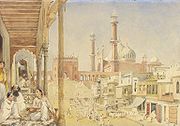
Chikan (embroidery)
Chikan is a traditional embroidery style from Lucknow, India. Literally translated, the word means embroidery. Believed to have been introduced by Nur Jehan, Mughal emperor Jahangir's wife, it is one of Lucknow's most famous textile decoration styles....
and zari
Zari
Zari is basically a tinsel thread meant for weaving and embroidery. It is manufactured by winding or wrapping a flattened metallic strip made from pure gold, silver or slitted metallised polyester film, on a core yarn, usually of pure silk, art silk, viscose, cotton, nylon, polyester, P.P.,...
work. There are lots of narrow lanes with many shops selling books, clothing, shoes and leather goods, electronic and consumer goods and whatnot. The area, even more so than the rest of the city, is very congested. This is also a good place for window shopping. It is the location of the original Haldiram's. A particular local delicacy are the jalebi
Jalebi
-Further reading:*Epicure's Delectable Desserts of the World By Asha Khatau ISBN 81-7991-119-5...
s, which are fried in pure ghee
Ghee
Ghee is a class of clarified butter that originated in South Asia and is commonly used in South Asian cuisine....
(clarified butter).

- The GhantewalaGhantewalaThe Ghantewala Halwai in Chandni Chowk in Delhi, established in 1790 CE is one of the oldest halwais in India It has catered to Mughal Emperors, Presidents and Prime Ministers of India.-History:...
HalwaiHalwaiThe Halwai are a ethnic group found in India and Pakistan. The Arabic word Halwa means sweet and Halvai or Halwai means sweet-maker. In Pakistan they are considered a community while in India they are considered a caste. They are also known as Mithaya in Madhya Pradesh, Gudia in Orissa, Mayara in...
, established in 1790. - Natraj’s Dahi BhalleDahi vadaDahi vada is an Indian chaat, prepared by soaking vadas in thick yogurt ....
, established in 1940. - Kanwarji Bhagirathmal DalbijiDal bijiDal Biji is an Indian snack made of gram flour noodles and cantelope seeds and and musk melon seeds....
wallah established in mid-19th century. - Chaatwallah established in 1923, famous for fruit chaat.
- Bikaner Sweet Shop famous for rasmalai.
- Gianiji ka Falooda famous for Rabri FaloodaFaloodaFalooda or Faluda is a cold and sweet beverage with many ingredients very popular in South Asia. Traditionally it is made by mixing rose syrup with vermicelli, psyllium or basil seeds, jelly pieces and tapioca pearls along with either milk, water or ice cream.Falooda is an adaptation of the...
, established around 1947. - Paranthe wali Gali with parathaParathaA paratha/parantha/parauntha is an Indian flat-bread that originated in the Indian subcontinent. Paratha is an amalgamation of the words parat and atta which literally means layers of cooked dough...
shops from 1875-1886. - Meghraj and Sons, since 1950s (?)
- Chainaram established in 1948
Some of the historical mansions include:
- Begum Samru's Palace of 1806 (see http://www.collectbritain.co.uk/personalisation/object.cfm?uid=019ADDOR0005475U00047VRB&largeimage=1#largeimage)now called Bhagirath Palace.
- Naughara mansions in Kinari Bazaar, 18th century Jain mansions.
- Khazanchi haveli, khajanchi were the accountants of Shah Jahan. There is a street named after them called "Gali Khajanchi", a long underground tunnel connects the haveli and the red fort, so that money could be transferred safely.
- Haveli of Mirza GhalibMirza GhalibDabir-ul-Mulk, Najm-ud-Daula Mirza Asadullah Baig Khan , pen-name Ghalib and Asad , was a classical Urdu and Persian poet from India during British colonial rule...
, Gali Kasim Jan (Gali Ballimaran) - Chunnamal haveliChunnamal haveliRai Lala Chunnamal ki Haveli is the only well-preserved haveli in the walled city of old Delhi in the Chandni Chowk area.Lala Chunnamal and his family were Khatri merchants of brocade and textiles during the Mughal period...
, Katra Neel - Haveli of Zinat Mahal, Lal Kuan Bazar
- Haksar Haveli, Bazar Sitaram, where Jawaharlal NehruJawaharlal NehruJawaharlal Nehru , often referred to with the epithet of Panditji, was an Indian statesman who became the first Prime Minister of independent India and became noted for his “neutralist” policies in foreign affairs. He was also one of the principal leaders of India’s independence movement in the...
was married in 1916 to Kamla Nehru. - Haveli Naharwali, Kucha Sadullah Khan, where Pervez MusharrafPervez MusharrafPervez Musharraf , is a retired four-star general who served as the 13th Chief of Army Staff and tenth President of Pakistan as well as tenth Chairman of the Joint Chiefs of Staff Committee. Musharraf headed and led an administrative military government from October 1999 till August 2007. He ruled...
, former president of Pakistan was born.
Chandni Chowk in Indian films

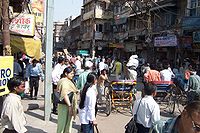
Bollywood
Bollywood is the informal term popularly used for the Hindi-language film industry based in Mumbai , Maharashtra, India. The term is often incorrectly used to refer to the whole of Indian cinema; it is only a part of the total Indian film industry, which includes other production centers producing...
film Kabhi Khushi Kabhie Gham
Kabhi Khushi Kabhie Gham
Kabhi Khushi Kabhie Gham... is a Bollywood film released in India and countries with large NRI populations on 14 December 2001....
where the leading lady Anjali (Kajol
Kajol
Kajol Devgn , better known as Kajol, is an Indian film actress appearing in Hindi films. She is regarded as one of India's most successful and talented female actors....
) and her sister Pooja (Kareena Kapoor
Kareena Kapoor
Kareena Kapoor , often informally referred to as Bebo, is an Indian actress who appears in Bollywood films. During her career, Kapoor has received six Filmfare Awards, among nine nominations, and has been noted for her performances in a range of film genres; these include her work from contemporary...
) lived. Though portrayed as a neighborhood populated by a lower-class population, Chandni Chowk is shown to be a rich, cultural hub.
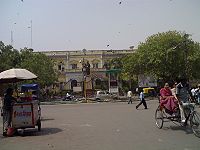
Anil Kapoor
Anil Kapoor is an Indian actor and producer who mainly appears in Bollywood films. He won a Filmfare Best Supporting Actor Award for his role in Yash Chopra's film Mashaal ....
, Anurag Sinha
Anurag Sinha
Anurag Sinha is an actor from India. He has made entry into Bollywood by acting in Black & White. Anurag did his schooling from Scindia School, Gwalior and his graduation in Chemistry from St. Stephen's College in Delhi...
, Shefali Chhaya, and Aditi Sharma is set in Chandni Chowk.
The 2009 Bollywood movie Chandni Chowk to China
Chandni Chowk To China
Chandni Chowk to China , shortened as CC2C is a Hindi film which released on 16 January 2009. It is directed by Nikhil Advani and stars Akshay Kumar and Deepika Padukone in the lead roles, with Hindi cinema veteran Mithun Chakraborty and Hong Kong action cinema veteran Gordon Liu among the co-stars...
starring Akshay Kumar
Akshay Kumar
Akshay Kumar is an Indian film actor, producer and martial artist who has appeared in over a hundred Hindi films. When he began his acting career in the 1990s, he primarily starred in action films and was particularly known for his appearances in feature films commonly called the "Khiladi series",...
, Deepika Padukone
Deepika Padukone
Deepika Padukone is an Indian actress and a former model. She appears mostly in Hindi as well as Tamil and Kannada language films. Born to Badminton player Prakash Padukone, she chose to become an actress and not pursue a career in sports.Padukone made her acting debut in the 2006 Kannada film...
, Mithun Chakraborty
Mithun Chakraborty
Mithun Chakraborty is an Indian film actor, social activist, and entrepreneur, who has won three National Film Awards. He made his acting debut with the arthouse drama Mrigaya , for which he won his first National Film Award for Best Actor....
, and Ranvir Shorey
Ranvir Shorey
Ranvir Shorey is an Indian actor and former VJ. Since making his debut in Ek Chotisi Love Story , he has starred in a number of high profile films such as Jism and Lakshya...
features some scenes depicting the city.
The 2009 Bollywood movie Delhi-6
Delhi-6
Delhi-6 is a 2009 Hindi-language film directed by Rakeysh Omprakash Mehra and starring Abhishek Bachchan, Sonam Kapoor, Om Puri, Waheeda Rahman, Rishi Kapoor, Atul Kulkarni, Deepak Dobriyal and Divya Dutta. The film is reportedly based on Mehra's growing up years in Chandni Chowk area of Old...
starring Abhishek Bachchan
Abhishek Bachchan
Abhishek Bachchan is an Indian actor and producer. He is the son of Indian actors Amitabh Bachchan and Jaya Bachchan and is married to actress and former Miss World Aishwarya Rai....
, Sonam Kapoor
Sonam Kapoor
Sonam Kapoor is an Indian film actress who appears in Bollywood films. Kapoor made her acting debut in the unsuccessful film Saawariya opposite newcomer Ranbir Kapoor, which earned her a nomination for Filmfare Award for Best Female Debut. She earned her first commercial success in I Hate Luv...
, Waheeda Rehman
Waheeda Rehman
Waheeda Rehman , is an Indian film actress who appears in Bollywood movies and is known for many successful and critically acclaimed movies from 1950's, 60's and early 70's most notably C.I.D. and Guru Dutt classics such as Pyaasa , 12 O'Clock , Kaagaz Ke Phool , Sahib Bibi Aur Ghulam...
, Om Puri
Om Puri
Om Puri is an Indian actor who has appeared in both mainstream Indian films and art films. His credits also include appearances in British and American films. He has received an honorary OBE.-Early life:...
, Atul Kulkarni
Atul Kulkarni
Atul Kulkarni born 10 September 1965 is an Indian actor who has won two National Awards and has superstar status in Marathi film industry after successful movies like Valu and Natarang....
and Divya Dutta
Divya Dutta
Divya Dutta is an Indian actress from Ludhiana, Punjab, India who appears in Hindi and Punjabi films.- Career :She did her schooling from Sacred Heart Convent, Ludhiana...
is set in the ancient Walled City of Old Delhi
Old Delhi
Old Delhi , walled city of Delhi, India, was founded as Shahjahanabad by Mughal Emperor Shahjahan in 1639. It remained the capital of the Mughals until the end of the Mughal dynasty....
and centred around Chandni Chowk.
See also
- Dariba Kalan
- Central Baptist ChurchCentral Baptist Church (Delhi)Central Baptist Church is located on the main Chandni Chowk Road, just opposite Gurdwara Sisganj and before the Fountain Chowk in Delhi, India. It is probably the oldest Christian mission in the whole of the northern Indian region...
- Gali paranthe waleeGali paranthe waleeGali Paranthe Wali or Paranthe wali Gali , is the name of a narrow street in the Chandni Chowk area of Delhi, India, noted for its series of shops selling paratha, a fried Indian bread, and now a popular culinary destination.-History:Chandni Chowk was established in 1650 and was built along with...
- Jainism in DelhiJainism in DelhiDelhi is an ancient center of Jainism, home to over 165 Jain temples. Delhi has a large population of Jains spread all over the city. It has had continued presenece of a Jain community throughout its history, and it is still a major Jain center....
Further reading
- Delhi, the emperor's city: rediscovering Chandni Chowk and its environs, by Vijay Goel. Lustre Press, 2003. ISBN 8174362401.

